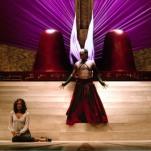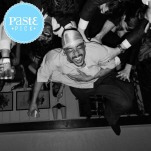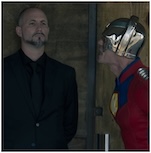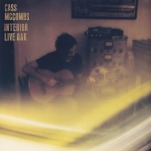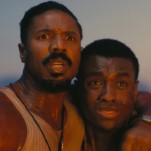Candyman‘s Compelling, Thoughtful Horror Digs Its Hook In Deep
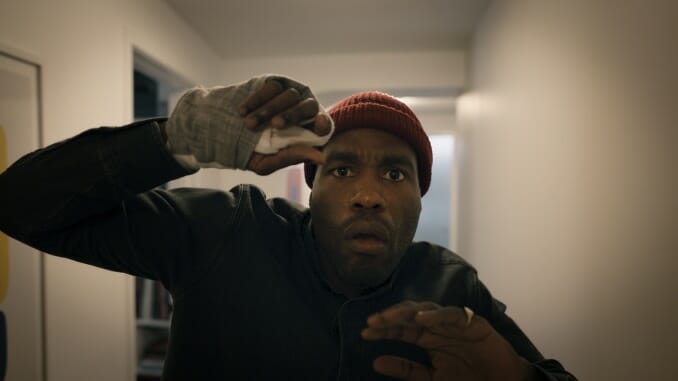
The problem with writing about Candyman is that you will inevitably have to write “Candyman” five times. What if my monitor suddenly craps out, leaving me to see a paranormal entity rocking a full-length shearling behind my dark reflection? Unlike many of the white Chicagoans in writer/director Nia DaCosta’s slasher sequel, I’m not foolish enough to tempt the Bloody Mary of the Near North Side. I am, however, still drawn to her update of the legend, which manages to pick up the original film’s pieces and put them back together in a compelling, reclamatory collage.
Ignoring the rest of the Candyman series in favor of a direct follow-up to Bernard Rose’s allegory-rich 1992 slasher, DaCosta introduces fancy-pants artist Anthony (Yahya Abdul-Mateen II) to the same urban legend that consumed lookie-loo grad student Helen Lyle. The original story adapted Clive Barker to U.S. racism and wealth inequality—particularly in Chicago, and even more particularly in Chicago’s Cabrini-Green projects. Now its homes and high-rises have been demolished or abandoned. A massive Target overlooks its northwest border, where you can buy athleisure and grab an in-house Starbucks before heading to Panera Bread. Gentrification may have neatly plastered over history, but that history cannot be so easily erased. “A story like that—a pain like that—lasts forever,” says Colman Domingo’s long-timer laundryman Burke. “That’s Candyman.”
DaCosta makes it clear that Anthony’s pulled by the legend, by history, more intimately than Helen ever was, and updates her scares in turn. The nightmarish apartments and putrid bathrooms Helen crawled through and photographed neatly reflected the entity haunting them; but the projects have been paved over, and Candyman persists. DaCosta shoots the city accordingly, either in dividing straight lines, or fully warped: You never notice how Marina City’s towers look like beehives until they’re flipped upside-down. Spurred on by Anthony’s interest, Candyman’s now an inevitability in every reflective surface. You can’t look away from DaCosta’s inspired compositions and layouts, your eyes led from one dark corner to the next with an Invisible Man-like mastery of negative space. One of these days, you think, she’s going to run out of ideas about how to shoot a mirror kill. Not so, especially in her world of omnipresent, physically and psychically painful self-reflection.
The idea of plumbing one’s history—be it personal or more culturally wide-ranging—permeates Candyman, starting with Anthony’s art. A creative slump is what initially draws him to the legend, which in turn draws a throughline between the horror films involving ambition-driven obsession, with interpersonal relationships pushed to the wayside or completely overrun by careerist selfishness. Why bother becoming more than a cultural tourist when you can turn suffering into your opus? It’s a seductive Devil’s bargain, and Anthony initially takes up Helen’s mantle—Abdul-Mateen II letting a similarly ghoulish smirk play on his lips—mirrored by those critiquing (a cynical and hilariously wealthy art critic) and curating (a wooing NYC power player) that art. It’s a diatribe against exploitation, scorching a creative sector that cares more about pushing a person’s brand than their output.
Anthony’s girlfriend and art curator Brianna (consistent standout Teyonah Parris) is the only one to fully resist this urge. She knows her pain, where she comes from, and isn’t about to sell it out despite there being plenty of bidders. Her self-assurance and sensibility (often the source, along with Nathan Stewart-Jarrett, of the movie’s funniest “Uh, no way am I doing that” gags) makes Anthony’s painful psychological journey all the more frightening. The more he understands about himself and about his city, the more he’s corrupted by Candyman. He’s not just bringing hook-handed bloodletting wherever he goes; his pockmarked skin slowly brings this existential anxiety to body horror. Brianna’s potent, levelheaded dismay is matched beat for beat by Abdul-Mateen II’s hypnotized, driven dread.
-

-

-

-

-

-

-

-

-

-

-

-

-

-

-

-

-

-

-

-

-

-

-

-

-

-

-

-

-

-

-

-

-

-

-

-

-

-

-

-


